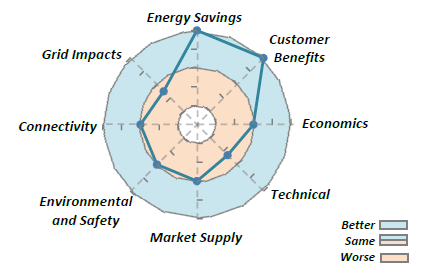EPRI Guide Helps Utilities Identify Technologies Best Positioned for Cost-Effective Deployment
What is the cheapest, most environmentally benign electricity resource today? While most people first think of emissions-free wind and solar power, the answer is energy efficiency—the use of technologies that consume less energy to provide the same service.
Twenty-four U.S. states recognize the value of energy efficiency by setting mandatory or voluntary targets for electric utilities, which in turn encourage residential, commercial, and industrial customers to invest in energy-saving products such as LED (light-emitting diode) lamps, thermostat controls, and heat pumps. But with so many efficiency products, either new or under development, it can be daunting for utilities to identify the most promising ones for their energy-efficiency programs.

In 2012, EPRI created its Energy Efficiency Technology Readiness Guide to help utilities determine the most cost-effective technologies with potential for broad deployment. Updated annually, the guide serves as a useful reference for utilities with long-standing and newly created efficiency programs. A 2015 update is available.
“We provide a systematic assessment of technologies at different stages in the R&D pipeline, based on our own evaluations and drawing on input from utility program administrators and technology developers,” said EPRI Project Manager Tom Geist.
The guide reviews dozens of technologies in five development phases:
- Technology scouting. These early-stage technologies could become candidates for utility programs. Technologies often enter the pipeline through EPRI’s Technology Innovation program, national laboratories, and universities.
- Assessment and lab testing. Technologies advance to EPRI’s End-Use Energy Efficiency and Demand Response program for laboratory testing and assessment.
- R&D field tests and demonstrations. Based on laboratory performance, technologies graduate to field tests by EPRI and others, on a scale of tens to hundreds of units.
- Coordinated early deployments. These larger-scale technology tests validate results from earlier stages and address challenges in supply chain and customer adoption.
- Full program rollout. Technologies are deployed in utility energy efficiency programs.
“At some point in the pipeline, EPRI has supported each of the technologies through concept assessments, testing, case studies, or detailed cost-benefit analyses,” said Geist. “This helps to move high-potential technologies through the pipeline and into efficiency programs.”
The 2014 guidebook provides two-page briefings for 35 technologies, each with a short description of the device; testing results; technical information on cost, safety, environment, and grid impacts; images and graphics; requirements for advancing to the next stage of the pipeline; and an overall readiness score (see chart).
Technology readiness scores range from 0 to 100, with higher scores for devices further along in the pipeline. For example, electrochromic windows—which rely on layers of thin films on glass to control the amount of visible and infrared light entering buildings—are at the scouting stage with a technology readiness score of 10. Several types of residential and commercial heat pumps score from 40 to 75. LED lamps to replace incandescent bulbs are already included in many utility efficiency programs, scoring a 95.
Using this information, utilities can gain insights on those technologies best positioned to achieve cost-effective energy savings in their service territories now and in the future.
“We are working to fill the gap between the very detailed technical information of interest to engineers and more application-specific information,” said Geist. “The Technology Readiness Guide is right in the middle.”
EPRI Technical Expert:
Tom Geist


